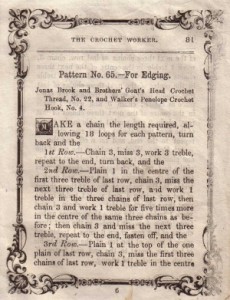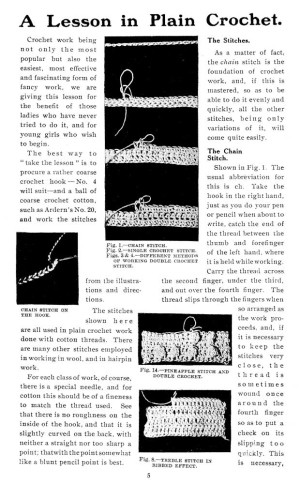| UK | US |
| ss | slst |
| dc | sc |
| htr | hdc |
| tr | dc |
| dtr | tr |
| miss | skip |
| yoh | yo |
| tension | guage |
Understanding Crochet Terms
Although there is some speculation that that the art of crochet evolved from traditional practices in other places, there is no evidence of it being performed before its popularity in Europe during the 1800s. The word “crochet” is derived from the French word , meaning hook.
the French word , meaning hook.
At one time all the terms were the same, if slightly different to the way we are accustomed to seeing them now. This picture is a page from
“The Crochet Worker” published in London in about 1860. This particular booklet is the 6th in the series. “Plain” refers to what we now call a “slip stitch”, noted as ss in modern patterns.
In the later book, ”The Craft of the Crochet Hook” printed in around 1912 you can see that the slipstitch is now referred to as a “single”. Patterns were written without as much detail as you get today, as it was assumed you knew the basics to be able to follow them. If you are an experienced crocheter, you can follow these patterns quite easily. A beginner may have some difficulty as things like the turning chains were omitted.
Another thing which was common practice in early crochet was to fasten off at the end of each row and re-attach the thread at the beginning. This meant the work was one sided and there were lots of ends to sew in. The modern practice of turning and working back along the row is much quicker and easier, as well as making the work reversible.
When crochet went to America, the terms were still the original ones. Many of the early crochet books in the US were reprints of the British and European publications. Somewhere along the years, the terms changed in the US. Britain, Europe and Australia still follow the “old” terms which are now known as “British” or “UK” terms while the US has a whole new terminology of its own.
What confuses many a crocheter is that the terms used are the same but refer to different stitches. A dc (double crochet) is used in both UK and US terminology but refers to a different stitch. 
There are certain things to look for to tell whether the pattern is UK or US terms.
Hook Sizes are usually metric in UK patterns, while US hooks are sized with letters.
Yarn in the UK is usually 3-ply, 4-ply, Double Knit or chunky and usually fingering, sport, worsted or bulky in US patterns. Thread is pretty much the same in both. Both terminologies have stitches which are unique to them. UK patterns have htr as a stitch and US patterns have sc and hdc as stitches. There are also other terms which are not actual stitches, “miss” and “yoh” in UK patterns while US patterns use “skip” and “yo”. Also, in US patterns “tension” is called “gauge” and there will be certain spelling differences like colour/colour.
Here are the stitch conversions
The easiest way to convert the patterns is to copy and paste the text into a word document, then use the “Replace” tool.
Make sure you set it to “Find whole words only” other wise you will end up changing letters in the middle of other words. Click on “More” to find this option.
It is important to change the stitches in the right order.
| UK to US | US to UK |
| dc – sc | tr – dtr |
| htr – hdc | dc – tr |
| tr – dc | hdc – htr |
| dtr – tr | sc – dc |
| miss – skip | skip – miss |
| yoh – yo | yo yoh |
You can also change the language in the document to the one you are converting to, then do a spell check. This will alter things like colour/color.
This will not be a perfect conversion as there are other minor differences but it will make the pattern so much easier to understand, especially if it is an intricate one.
The books referred to are now out of copyright, although some have been reprinted and republished by another publisher. Both of these original books, along with many others, are freely available from the Antique Pattern Library under a Creative Commons Licence.
The Antique pattern Library is at –www.antiquepatternlibrary.org/
My site is Rainbow Valley –www.enfys.me.uk/
Helen
You must be logged in to post a comment Login